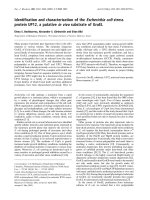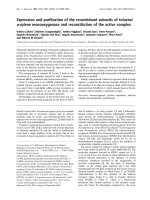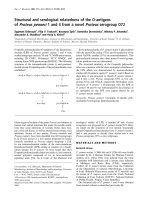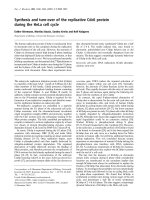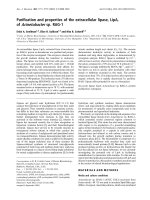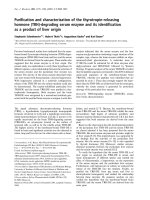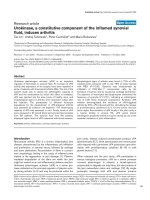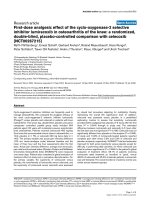Báo cáo y học: "Urokinase, a constitutive component of the inflamed synovial fluid, induces arthritis" pps
Bạn đang xem bản rút gọn của tài liệu. Xem và tải ngay bản đầy đủ của tài liệu tại đây (911.53 KB, 9 trang )
Introduction
Rheumatoid arthritis (RA) is a chronic inflammatory joint
disease characterised by the inflammatory cell infiltration
and proliferation of synovial tissue, followed by cartilage
and bone destruction. Accumulation of fibrin is a promi-
nent morphologic finding in the cavity of inflamed joints
implied in the aggravation of joint damage [1]. Plasmin-
mediated degradation of the fibrin net within the joint
might be viewed as an anti-inflammatory defence reaction.
Urokinase plasminogen activator (uPA) is a serine pro-
tease indicated as the principal regulator of plasmin activ-
ity during arthritis [2–5] and may be produced within the
joint cavity. Indeed, cultured chondrocytes produce uPA
spontaneously [6,7], while synoviocytes and mononuclear
cells respond with a prominent uPA production upon stim-
ulation with proinflammatory cytokines [8–10] or with
growth factors [11].
When released into the joint cavity, uPA participates in
various biological processes. uPA as a serine protease
converts plasminogen to plasmin, a broad-spectrum
enzyme able to degrade not only fibrin, but also proteins of
the joint extracellular matrix and cartilage [12]. By single
proteolytic cleavage, both uPA and plasmin produce
BSA = bovine serum albumin; ELISA = enzyme-linked immunosorbent assay; FACS = fluorescence-activated cell sorting; FCS = foetal calf serum;
H & E = haematoxylin and eosin; HGF = hepatocyte growth factor; HMW = high molecular weight; IFN-γ = interferon gamma; IL = interleukin; LMW =
low molecular weight; MMP = matrix metalloproteinase; PBS = phosphate-buffered saline; PPACK = H-D-Pro-Phe-Arg-chloromethylketone; RA =
rheumatoid arthritis; RF = rheumatoid factor; TNF-α = tumour necrosis factor alpha; uPA = urokinase plasminogen activator; uPAR = urokinase
plasminogen activator receptor.
Available online />Research article
Urokinase, a constitutive component of the inflamed synovial
fluid, induces arthritis
Tao Jin
1
, Andrej Tarkowski
1
, Peter Carmeliet
2
and Maria Bokarewa
1
1
Department of Rheumatology and Inflammation Research, Sahlgrenska University Hospital, Göteborg, Sweden
2
Center of Transgene Technology and Gene Therapy, Fanders Interuniversity Institute of Biotechnology, Campus Gasthuisberg, Leuven, Belgium
Corresponding author: Maria Bokarewa (e-mail: )
Received: 11 June 2002 Revisions received: 13 September 2002 Accepted: 25 September 2002 Published: 17 October 2002
Arthritis Res Ther 2003, 5:R9-R17 (DOI 10.1186/ar606)
© 2003 Jin et al., licensee BioMed Central Ltd (Print ISSN 1478-6354; Online ISSN 1478-6362). This is an Open Access article: verbatim copying
and redistribution of this article are permitted in all media for any non-commercial purpose, provided this notice is preserved along with the article's
original URL.
Abstract
Urokinase plasminogen activator (uPA) is an important
regulator of fibrinolysis in synovial fluid. An increase of uPA
activity and expression of its receptor have been reported in
joints of patients with rheumatoid arthritis (RA). The aim of the
present study was to assess the arthritogenic capacity of
uPA and the mechanisms by which this effect is mediated.
uPA was injected into the knee joints of healthy mice, and
morphological signs of arthritis were assessed 4 days after
the injection. The prerequisite of different leukocyte
populations for the development of uPA-triggered arthritis
was assessed by selective cell depletion. The inflammatory
capacity of uPA was assessed in vitro. Finally, levels of uPA
were measured in 67 paired blood and synovial fluid samples
from RA patients. The synovial fluid from RA patients
displayed higher levels of uPA compared with blood samples.
Morphological signs of arthritis were found in 72% of uPA-
injected joints compared with in only 18% of joints injected
with PBS (P < 0.05). Synovitis was characterised by
infiltration of CD4
–
Mac-1
+
mononuclear cells, by the
formation of pannus and by occasional cartilage destruction.
The absence of monocytes and lymphocytes diminished the
frequency of synovitis (P < 0.01), indicating an arthritogenic
role of both these leukocyte populations. Synthetic uPA
inhibitor downregulated the incidence of uPA-triggered
arthritis by 50%. uPA induced arthritis, stimulating the release
of proinflammatory cytokines IL-6, IL-1β and tumour necrosis
factor alpha. Accumulation of uPA locally in the joint cavity is
a typical finding in erosive RA. uPA exerts potent
arthritogenic properties and thus may be viewed as one of the
essential mediators of joint inflammation.
Keywords: arthritis, inflammation, urokinase plasminogen activator
Open Access
R9
R10
Arthritis Research and Therapy Vol 5 No 1 Jin et al.
active forms of matrix metalloproteinases (MMPs), a group
of enzymes that promote degradation of joint cartilage
[13,14]. uPA also exhibits an indirect stimulatory effect by
activating latent growth factors [15]. On the contrary, uPA
has been shown to be essential for the alleviation of
antigen-induced arthritis [16] and in defence during endo-
toxin challenge [17]. Moreover, uPA null mice show dimin-
ished T-cell proliferation capacity and a shifted cytokine
pattern to the T helper cell type 2 direction, displaying low
IFN-γ and IL-12 production but high IL-10 production [18].
uPA binds through its amino-terminal fragment to the
urokinase plasminogen activator receptor (uPAR), a
glycosylphosphatidylinositol-anchored molecule on the
cell wall that attracts proteolysis to the cell surface. Peri-
cellular proteolytic processes triggered by the uPA/uPAR
interaction evoke various cell events including adhesion
and proliferation, chemotactic migration and differentiation
that are of vital importance for the innate immune
response (reviewed in [19]).
The complexity of the processes taking place in the
inflamed joint does not permit a definitive conclusion
about the role of uPA in the development of arthritis, at
least not in a human setting. We demonstrate that intra-
articular injection of highly purified uPA induces arthritis in
naïve mice. The inflammation is characterised by abundant
mononuclear cell infiltration, pannus formation and occa-
sional development of erosions. Furthermore, we demon-
strate that the serine proteinase activity of uPA rather than
its interaction with the uPAR is essential for the develop-
ment of joint inflammation.
Materials and methods
Synovial fluid and blood samples
Synovial fluid and blood samples were collected from 67
patients with RA (aged 29–87 years) who attended the
Rheumatology Clinic, Sahlgrenska University Hospital,
Göteborg for acute joint effusion. Forty-six patients dis-
played erosive joint disease, as detected by X-ray imaging,
and 47 patients were positive for rheumatoid factor (RF).
Synovial fluid was aseptically aspirated and transferred
into tubes containing sodium citrate (0.129 mol/l; pH 7.4).
Blood samples from all 67 RA patients were simultane-
ously obtained from the cubital vein and directly trans-
ferred into sodium citrate medium. Blood samples from 22
healthy individuals (aged 32–66 years) were used in the
control group. The collected blood and synovial fluid
samples were centrifuged at 800 × g for 15 min, aliquot-
ted and stored frozen at –20°C until use.
Mice and reagents
Female NMRI mice (6–8 weeks old, weighing 25–30 g)
were purchased from ALAB (Stockholm, Sweden). SCID
mice were obtained from Charles River Laboratories
(Uppsala, Sweden). The breeding pairs of IL-1 receptor
type I knockout mice and their transgenic counterpart
C57BL/6 mice were purchased from Jackson Laboratory
(Bar Harbor, ME, USA). The mice were bred and housed
in the animal facility of the Department of Rheumatology,
University of Göteborg, under standard conditions of tem-
perature and light, and were fed laboratory chow and
water ad libitum. The uPAR knockout mice and their trans-
genic counterpart (75% BL6/25% 129) [20] were bred at
the animal facility of the Center for Transgene Technology
and Gene Therapy, University of Leuven, Belgium. Human
low molecular weight (LMW)-uPA was purchased from
American Diagnostica (Greenwich, CT, USA), and high
molecular weight (HMW)-uPA was from Medac
(Hamburg, Germany).
Injection protocol and cell depletion procedures
NMRI mice were used in all the experiments unless stated
otherwise. Both HMW-uPA and LMW-uPA were injected
intra-articularly into the right knee joint in a total volume of
20 µl. Control mice received an equivalent volume of PBS
buffer.
For monocyte depletion, mice were injected subcuta-
neously with etoposide (Bristol-Myers Squibb, Bromma,
Sweden; 12.5 mg/kg body weight in a volume of 100 µl)
on three consecutive days before and after the uPA injec-
tion. FACS analysis showed that such a procedure
depletes the monocyte population by more than 90%
[21]. To assess the role of lymphocytes, uPA was injected
into SCID mice lacking functional T lymphocytes and B
lymphocytes.
Inactivation of uPA with synthetic inhibitor
Synthetic peptide H-
D-Pro-Phe-Arg-chloromethylketone
(PPACK; Bachem, Feinchemikalien AG, Switzerland) was
used to inhibit the serine proteinase activity of uPA. To
allow complex formation, uPA (3 µM) was incubated with
30 µM PPACK in Tris–HCl buffer (pH 7.4) in a 37°C
water bath for 30 min. The inhibitory effect of PPACK was
evaluated by hydrolysis of S-2251 (0.3 mM; Chromogenix,
Mölndal, Sweden) in the presence of 300 nM Glu-plas-
minogen (Biopool, Umeå, Sweden). The preincubated
uPA–PPACK complex was injected intra-articularly into
the right knee joint of each mouse. Control mice received
PPACK alone (40 nmol/joint). In the parallel experiment,
40 nmol/mouse PPACK was injected intraperitoneally,
twice daily during three consecutive days after the intra-
articular injection of uPA.
Histopathological and immunohistochemical
examination of joints
Three days after the joint injection, the mice were sacri-
ficed by cervical dislocation and the right knee was
removed for histopathologic and immunohistochemical
examination. Histological examination of joints was carried
out after routine fixation, decalcification and paraffin
embedding of the tissue. Tissue sections of the knee joints
R11
were cut and stained with H & E. All the slides were
coded and evaluated blindly by two investigators with
respect to synovial hypertrophy, to the inflammatory cell
infiltration of the synovia, to pannus formation, and to carti-
lage and subchondrial bone destruction. Synovial hyper-
trophy was defined as a synovial membrane thickness of
more than two cell layers. The intensity of inflammatory cell
infiltration of the synovia (arthritis index) was graded arbi-
trarily from 0 to 8.
For immunohistochemistry, the knee joints were deminer-
alised in 10% EDTA–0.1 M Tris buffer (pH 6.95) by an
enzymatic procedure previously described in detail [22].
The demineralised specimens were frozen in isopentane,
and stored at –70°C. Serial cryosections (6 µm thick)
were fixed in acetone and depleted of endogenous peroxi-
dase activity by treatment with H
2
O
2
. Sections were
stained with rat monoclonal anti-CD11b (Mac-1, M1/70),
CD4
+
(GK 1.5), or CD8
+
(all antibodies obtained from
PharMingen, San Diego, CA, USA) in a humid chamber
overnight, followed by incubation with biotinylated sec-
ondary antibodies (rabbit antirat IgG; DAKO, Glostrup,
Denmark) and finally with avidin–biotin–peroxidase com-
plexes. The enzymatic reaction was developed using H
2
O
2
in 3-amino-9-ethyl-carbazole buffer (pH 5.5). Joint sections
were also stained with goat antimouse uPAR monoclonal
antibodies (Santa Cruz Biotechnology, Inc., Santa Cruz,
CA, USA) and then incubated with horseradish peroxide-
labelled secondary antibodies (rabbit antigoat; DAKO).
Control staining was performed using irrelevant goat IgG
(Jackson ImmunoResearch Laboratories, West Grove, PA,
USA). All sections were counterstained with Mayer’s
haematoxylin.
In vitro
spleen cell stimulation
Mice spleens were aseptically removed, and passed
through a nylon mesh. Erythrocytes were depleted by lysis
in 0.83% ammonium chloride, and the remaining cells
were carefully washed in PBS. The resulting single-cell
suspension was adjusted to a cell density of 1 × 10
6
/ml in
Iscove’s complete medium (10% FCS, 2 mM
L-glutamine,
5×10
–5
M mercaptoethanol and 50 µg/ml gentamicin).
Splenocyte cultures were stimulated with LMW-uPA and
HMW-uPA (final concentration between 60 and 0.6 nM).
Control cultures were stimulated with lipopolysaccharide
(10 µg/ml) and concavalin A (2.5 µg/ml). Supernatants
were collected at defined time points for the determination
of cytokine levels (see later).
To assess proliferative responses, a splenocyte suspen-
sion (1 × 10
6
/ml) in Iscove’s complete medium was added
to 96-well, flat-bottomed microtitre plates (Nunc, Copen-
hagen, Denmark) in triplicate and incubated with various
preparations of uPA (final concentrations between 60 and
0.6 nM) for 72 hours. Splenocyte stimulated with
lipopolysaccharide (10 µg/ml) served as a positive control.
During the last 12 hours, the cells were pulsed with 1 µCi
[
3
H]thymidine (Amersham, Bucks, UK). Cells were har-
vested into a glass fibre filter and thymidine incorporation
was measured in a β-counter. The results were expressed
as a stimulation index (mean ± SEM) and were compared
with nonstimulated cells.
Measurement of cytokine levels
IL-6 levels were measured by a bioassay employing the
cell clone B13.29, subclone B9, which is dependent on
IL-6 for its growth [23]. The cell suspension (1 × 10
6
/ml)
was incubated with sample supernatants for 72 hours and
pulsed with 1 µCi [
3
H]thymidine. Incorporation of thymi-
dine corresponded to the amount of IL-6 in the culture.
The results were compared with recombinant IL-6 stan-
dard (Genzyme, Cambridge, MA, USA).
IFN-γ levels were quantified by an ELISA. The 96-well, flat-
bottomed polyester plates (Nunc) were coated with rat
antimouse IFN-γ antibodies (2 µg/ml; Pharmingen, San
Diego, CA, USA) in carbonate buffer (pH 9.6) overnight.
After blocking with 1% Tris–BSA (pH 7.4), samples were
added and incubated for 2 hours at 37°C followed by
incubation with biotinylated antimouse antibodies
(2 µg/ml) overnight. Colour development was registered at
450 nm using extravidin alkaline phosphatase (0.5 mg/ml)
and substrate. Sample concentrations were calculated
using recombinant mouse IFN-γ (Genzyme).
Tumour necrosis factor alpha (TNF-α) and IL-1β levels
were determined using Quantikine™ ELISA kits (R&D
systems Inc., Abingdon, UK) following the manufacturer’s
instructions.
Measurement of uPA levels
The uPA levels in the plasma and synovial fluid samples
as well as in various preparations of uPA were deter-
mined as a total uPA antigen level, by a sandwich ELISA
(Haemochrom Diagnostica GmBH, Mölndal, Sweden)
following the manufacturer’s recommendation. Primary
antibodies consisted of a mixture of monoclonal antibod-
ies reactive with single-chain and two-chain variants of
uPA. Samples were tested in a 1: 20 dilution. The
obtained values were recalculated using the reference
curve.
Statistical analysis
The frequency of arthritis in groups was analysed by Fish-
er’s exact test. The severity of arthritis was compared
using the Mann–Whitney U test. The level of uPA in the
blood and synovial fluid samples as well as the level of
cytokines in the supernatants were expressed as the
mean ± SEM. Differences in the matched blood and syn-
ovial fluid samples were analysed by the paired t test. Dif-
ferences in the groups were calculated by the Mann–
Whitney U test. P < 0.05 was considered significant.
Available online />Results
Accumulation of uPA in synovial fluid of RA patients
The plasma levels of uPA in RA patients (n = 67) proved
to be significantly higher compared with those in healthy
controls (n = 22) (29.9 ± 4.4 versus 1.3 ± 0.3 ng/ml,
P < 0.0001). The concentration of uPA in the joints of RA
patients (71.5 ± 11.9 ng/ml) was even higher than in the
matching blood samples (P < 0.0001). The uPA levels in
synovial fluid were strongly related to the corresponding
blood level (r = 0.80, P < 0.0001) (Fig. 1) and to the dura-
tion of the disease (P < 0.05). Levels of uPA correlated
neither to the blood levels of acute phase reactants
(C-reactive protein, sedimentation rate) nor to the white
blood cell/neutrophil counts in synovial fluid. The RA
patients positive for RF had higher levels of uPA com-
pared with those patients negative for RF. This observa-
tion was true both in the case of blood samples
(36.5 ± 6.0 versus 20.0 ± 5.5 ng/ml, not significant) and
in the case of synovial fluid samples (79.2 ± 11.9 versus
38.9 ± 8.2 ng/ml, P = 0.032).
The most striking difference with respect to the uPA levels
in blood and in synovial fluid was observed when the
patients were stratified with respect to erosive joint
disease and RF. The uPA level was high in patients with
erosive joint disease who were positive for RF (n = 38),
compared with those with erosive disease who were RF
negative (n = 8) (blood, 37.3 ± 7.1 versus 5.9 ± 1.9 ng/ml,
P < 0.05; synovial fluid, 83.8 ± 14.0 versus
22.5 ± 9.2 ng/ml, P < 0.05). In contrast, patients with
nonerosive joint disease revealed no differences of uPA
levels with respect to the presence or absence of RF.
Intra-articularly deposited uPA is arthritogenic
The arthritogenic capacity of uPA was tested by a single
intra-articular injection of both HMW-uPA and LMW-uPA
into the knee joint of healthy mice. The concentrations
tested spanned between 60 and 0.6 pmol/knee (from
2000 to 20 ng/knee). Morphological evaluation of the
injected joints with respect to hypertrophy and inflamma-
tory cell infiltration of the synovia, to pannus formation
and to the development of bone erosions was performed
on the fourth day after instillation of uPA. The reason for
choosing this timeframe was to avoid potential immune
reactivity to the heterologous protein. Both the frequency
and severity of arthritis exhibited a dose-dependent
pattern. The highest frequency of arthritis was observed
using 60 pmol/knee LMW-uPA and reached 72% (22
out of 31 mice), being significantly higher than that of
control joints injected with an equal volume of PBS
buffer (four out of 20 mice, P < 0.05). Synovitis (severity
1–8, mean 2.8 ± 1.9) was observed in all cases of arthri-
tis. In addition, pannus formation (n = 5) and bone ero-
sions (n = 2) were found (Fig. 2). The equivalent dose of
HMW-uPA gave rise to arthritis in 40% of cases (four
out of 10 mice), and the frequency remained low even
when a 50 times higher concentration was used (data
not shown).
To assess the role of the uPAR in the mediating of inflam-
mation after injection of uPA, uPAR
–/–
mice and their
genetic counterpart (75% BL6/25% 129, as indicated in
Materials and methods) were injected with 60 pmol/knee
LMW-uPA. Morphological features of arthritis were found
in 83% of uPAR
–/–
mice, demonstrating no significant dif-
ference from the control group possessing uPAR (5/6
versus 6/8, not significant).
The cellular composition of the synovial infiltrates as
assessed by immunohistochemical staining of joint sec-
tions revealed the dominance of Mac-1
+
mononuclear
cells, while CD4
+
and CD8
+
cells were rarely observed in
the synovial tissue (Fig. 3). uPAR expression was absent
in the joints injected with LMW-uPA.
Monocytes and lymphocytes are essential for the uPA-
induced inflammation
LMW-uPA (60 pmol/joint) was used to evaluate the role of
different leukocyte populations in the development of uPA-
induced arthritis. Depletion of peripheral monocytes with
etoposide resulted in a remarkable reduction in the fre-
quency and severity of synovial inflammation, since only
one out of 12 mice (8%, severity mean 0.5 ± 0.2) devel-
oped arthritis. Analogously, injection of LMW-uPA into
SCID mice lacking functional T lymphocytes and B lym-
phocytes resulted in arthritis only in two out of eight mice
Arthritis Research and Therapy Vol 5 No 1 Jin et al.
R12
Figure 1
Accumulation of urokinase plasminogen activator (uPA) in the synovial
fluid of patients with rheumatoid arthritis (RA). The level of uPA is
presented as the mean ± SEM (ng/ml). Significance regarding
differences between the groups is indicated.
0
40
80
120
Controls Non-erosive RA Erosive RA
Serum
Synovial fluid
P < 0.05
P < 0.05
uPA (ng/ml)
(25%, severity mean 0.75 ± 0.15). In both cases, the fre-
quency and severity of arthritis were significantly lower
than in the untreated animals exposed intra-articularly to
uPA (P < 0.05) (Fig. 4). The results allow us to conclude
that monocyte and lymphocyte cell populations are both
important for the development of uPA-induced arthritis.
uPA induces cytokine production
in vitro
To evaluate cytokine production by mouse spleen cells
exposed to uPA, single cell cultures were incubated with
LMW-uPA in a final concentration ranging from 0.6 to
60 nM. Supernatants were collected after 6, 24 and
48 hours of stimulation. IL-6 was found already after
6 hours of stimulation, and its concentration remained high
during 48 hours of culturing. The level of IL-6 was directly
related to the concentration of LMW-uPA (Fig. 5). Indeed,
treatment with 60 nM LMW-uPA resulted in 100-fold
increased IL-6 production compared with nonstimulated
cells (889 ± 134 versus 9 ± 6 pg/ml, P < 0.001). A differ-
ent pattern of stimulation was registered for TNF-α and IL-
1β. Both TNF-α and IL-1β appeared in supernatants first
after 24 hours of stimulation, and required lower doses of
LMW-uPA (6 nM) for the induction. Production of IFN-γ
was not detected in uPA-stimulated spleen cell cultures.
Stimulation of spleen cells from uPAR
–/–
mice (n = 3) with
LMW-uPA for 48 hours demonstrated a similar dose-
dependent increase in IL-6 (3093 ± 564 pg/ml when stim-
ulated with 60 nM) and no change in the TNF-α levels in
the supernatants. The level of IL-6 did not differ from that
detected in the uPAR
+/+
supernatants (2972 ± 437 pg/ml,
n = 3).
Available online />R13
Figure 2
Histopathological appearance of arthritis after intra-articular injection of
low molecular weight urokinase plasminogen activator (LMW-uPA). (a)
Arthritic knee joint 4 days after the LMW-uPA injection (60 pmol/joint).
Infiltration of mononuclear cells in the synovial tissue is apparent.
Original magnification × 10. (b) Knee joint injected with PBS revealed
no signs of inflammation. Original magnification × 10. JC, joint cavity;
C, cartilage; ST, synovial tissue; P, pannus. Arrows indicate
inflammatory cell infiltration in the synovium and pannus formation.
Figure 3
Immunohistochemical staining of an arthritic knee joint injected with
low molecular weight urokinase plasminogen activator. (a) Abundance
of mononuclear cells expressing Mac-1 (red–brown colour) in the
inflamed synovial tissue. Original magnification × 20. (b) Arthritic knee
joint stained with irrelevant goat IgG. JC, joint cavity; C, cartilage;
ST, synovial tissue.
To further assess the role of IL-1 in the development of
uPA-induced arthritis, LMW-PA was injected intra-articu-
larly (60 pmol/knee) into the IL-1 receptor type 1 null mice.
A significant reduction in the frequency of arthritis was not
observed compared with the control group of C57BL/6
mice (4/10 versus 6/10, not significant).
Several preparations of uPA were tested in the in vitro
experiments. None of the uPA preparations (HMW-uPA or
LMW-uPA) induced proliferative activity of mouse spleen
cells. No change in the IL-6, TNF-α and IL-1β levels were
observed in the supernatants of NMRI, uPAR
–/–
and
uPAR
+/+
spleen cells after stimulation with HMW-uPA.
Serine proteinase activity of uPA is important for the
induction of arthritis
PPACK was used to inhibit the serine proteinase activity
of uPA. Systemic (intraperitoneal) and local (intra-articular)
methods of PPACK administration were tested. In both
sets of experiments, PPACK was efficient in diminishing
the frequency of the uPA-induced arthritis. When PPACK
was administered intraperitoneally, uPA-triggered arthritis
developed only in 36% of uPA-injected joints (P < 0.05).
The severity of arthritis was also significantly reduced
compared with that in untreated mice (1.2 ± 0.8 versus
2.8 ± 1.9, P < 0.05). Direct intra-articular administration of
PPACK was less efficient since, in 50% of joints injected
with the uPA–PPACK complex, the arthritis was visible
(not significant). These results indicate that the enzymatic
function of uPA as a serine proteinase is of importance in
mediating the inflammatory processes in the joint.
Discussion
The present results indicate that uPA is a constitutive
component of the inflamed synovial fluid in RA joints.
Increased levels of uPA detected locally in joints as com-
pared with those in plasma of the same patients indicate
either accumulation or, more probably, production of uPA
by the cells invading the synovial tissue during the process
of arthritis. The significant correlation observed between
the uPA levels in the synovial fluid and the erosivity of
arthritis suggests the regulatory role of uPA in joint
destruction. However, direct proof of the arthritogenic
properties of uPA is still lacking. The present study
demonstrates that injection of uPA directly into the joints
of healthy mice triggers arthritis, characterised by synovial
inflammation and occasional cartilage destruction, and
Arthritis Research and Therapy Vol 5 No 1 Jin et al.
R14
Figure 4
Essential role of monocytes and lymphocytes for the development of
urokinase plasminogen activator (uPA)-induced arthritis. Frequency of
histological signs of arthritis 4 days after a single injection of low
molecular weight uPA (60 pmol/knee). Significance regarding the
difference of incidence of arthritis between the groups is indicated.
0
50
100
u-PA alone Monocyte depletion Absence of T/B
l
y
mphoc
y
te
Frequency of arthritis (%)
P < 0.05
Figure 5
In vitro cytokine production following stimulation with low molecular
weight urokinase plasminogen activator for 48 hours. (a) IL-6 (n = 10),
(b) tumour necrosis factor alpha (TNF-α) (n = 6), and (c) IL-1β (n = 4).
Levels of cytokines are presented as the mean ± SEM (pg/ml).
Significant difference in the groups is indicated; n.s., not significant.
0
400
800
1200
60 nM 6 nM 0.6 nM non-
stimulated
0
30
60
90
60 nM 6 nM 0.6 nM non-
stimulated
0
3
6
9
P < 0.05
n.s.
P < 0.05
IL-6 (pg/ml)
(a)
(b)
TNF-α (pg/ml)
(c)
IL-1β (pg/ml)
60 nM 6 nM 0.6 nM non-
stimulated
provides the first direct evidence for the inflammato-
genic/destructive role of this molecule in vivo.
Using a synthethic serine protease inhibitor (PPACK), we
demonstrated that serine protease activity is essential for
the proinflammatory effect of uPA. Substrates to be
activated by uPA include plasminogen, MMPs and plas-
minogen-related growth factors (hepatocyte growth factor
[HGF] and macrophage stimulating proteins), molecules
participating in the degradation of the extracellular matrix
and the regulation of angiogenesis [12,15]. The clinical
relevance of MMPs and plasminogen in joint inflammation
is based on the studies of the synovial fluid and tissues of
RA patients that revealed an association between the level
and localisation of these molecules with uPA [24,25].
Further support was obtained in animal models when
downregulation of MMPs resulted in alleviation of antigen-
induced arthritis [26–28]. In the present experiments, it
has been clearly demonstrated that LMW-uPA gave rise,
in a dose-dependent way, to the production of inflammato-
genic and tissue-destructive cytokines (Fig. 4). IL-6, TNF-α
and IL-1β have all been previously demonstrated to partici-
pate in joint inflammation in human RA [29,30] and in
experimental arthritis [31]. However, other effects of
LMW-uPA once in the joint cavity cannot be excluded.
Indeed, plasmin and HGF may be considered possible
mediators of the uPA-induced inflammation, since both
molecules act as chemoattractants for mononuclear cells
[32–34], an important constituent of the synovial infiltrate
in the uPA-induced arthritis. However, in our experimental
model, intra-articular injection of plasmin/plasminogen
resulted neither in a mononuclear cell influx in the synovial
tissue nor in IL-6 production in vitro (results not shown).
These observations allow one to suggest that plasmino-
gen is not the major mediator of the uPA-induced inflam-
mation.
Pannus formation was a remarkable finding in uPA-
induced arthritis, taking into consideration the short time
course of our experiments and the self-limiting character
of inflammation. HGF is proposed to regulate the develop-
ment of synovial hyperplasia [35,36]. In this context, uPA
controls the formation of functional HGF on the surface of
endothelial cells and monocytes [37,38]. The earlier find-
ings together with the present data make HGF a possible
candidate for the mediation of uPA-induced synovitis. This
suggestion finds further support in the HGF-mediated
release of inflammatory cytokines (IL-6 and
granulocyte–macrophage colony-stimulating factor) by
human monocytes [34].
The uPA-induced arthritis may be mediated, besides its
proteolytic and cytokine triggering effects, by a direct
interaction with the uPAR, a high affinity receptor that is
constitutively expressed on peripheral blood leukocytes
and may be found on the cultured cells of joint tissues,
such as synoviocytes and chondrocytes [11]. In the
present study, however, we have demonstrated that inter-
action with the uPAR is not essential for the development
of uPA-induced arthritis. First, the LMW-uPA used for the
intra-articular injections lacks the N-terminal fragment nec-
essary for binding to the receptor. Second, the injection of
LMW-uPA to uPAR null mice resulted in arthritis. In addi-
tion, we were unable to detect the expression of uPAR in
the murine inflamed joints injected with uPA.
Mononuclear cell infiltration of synovia is a typical sign of
early RA, which is found in the majority of asymptomatic
subjects preceding clinically overt arthritis [39,40]. The
Mac-1
+
CD4
–
mononuclear cells were by far the most pre-
dominant cell population in the inflamed synovial tissue
triggered by delivery of uPA, thereby sharing this feature
with early RA.
Intriguingly, the HMW-uPA, possessing both full serine
protease activity and the amino-terminal fragment interact-
ing with the uPAR, appeared to be less efficient both in
giving rise to the cytokine production and in evoking joint
inflammation. Analogous to our observations, HMW-uPA
did not induce proinflammatory signalling in polymorpho-
nuclear cells [41]. Both HMW-uPA and LMW-uPA are the
two naturally existing forms of the uPA. Cleavage of the
HMW-uPA is performed by several proteases including
MMPs and plasmin, resulting in the release of the LMW-
uPA molecule, and may serve as a feedback mechanism
of the uPA-induced inflammation. Analysis for different
forms of uPA in the synovial fluid indicated an excess of
thrombin-cleaved uPA molecules that may be further acti-
vated by cathepsin C [42]. Little is known about the physi-
ological role of LMW-uPA. It has been hypothesised that
fragments of neutral and immunologically inert substances
(e.g. hyaluronan, collagen-like polypeptides, fibrin degra-
dation products, fibronectin) have biological activities dif-
ferent from their high molecular mass precursor molecules
[43–46]. Similar reasoning could be applied with respect
to uPA.
Conclusion
In conclusion, we have demonstrated that uPA, a constitu-
tive component of inflamed synovial fluid in RA patients, is
proinflammatory and may be responsible for an induc-
tion/perpetuation of intra-articular inflammation. In addi-
tion, the present results demonstrate that uPA mediates
its effect through a uPAR-independent but serine pro-
tease-dependent mechanism.
Acknowledgements
The study was approved by the Ethic Committee of Sahlgrenska Hos-
pital, and animal experimentation guidelines were followed. The work
has been supported by Göteborg Medical Society, Swedish Associa-
tion Against Rheumatism, King Gustaf V’s Foundation, Swedish
Medical Research Council, Nanna Svartz’ Foundation, Börje Dahlin’s
Foundation, National Inflammation Network and the University of Göte-
borg.
Available online />R15
References
1. Weinberg JB, Wortham TS, Misukonis MA, Patton KL, Chitneni
SR: Synovial mononuclear phagocytes in rheumatoid arthritis
and osteoarthritis: quantitative and functional aspects.
Immunol Invest 1993, 22:365-374.
2. Del Rosso M, Fibbi G, Matucci Cerinic M: The urokinase-type
plasminogen activator system and inflammatory joint dis-
eases. Clin Exp Rheumatol 1999, 17:485-498.
3. Brommer EJ, Dooijewaard G, Dijkmans BA, Breedveld FC: Plas-
minogen activators in synovial fluid and plasma from patients
with arthritis. Ann Rheum Dis 1992, 51:965-968.
4. Kummer JA, Abbink JJ, de Boer JP, Roem D, Nieuwenhuys EJ,
Kamp AM, Swaak TJ, Hack CE: Analysis of intraarticular fibri-
nolytic pathways in patients with inflammatory and noninflam-
matory joint diseases. Arthritis Rheum 1992, 35:884-893.
5. Busso N, Peclat V, So A, Sappino AP: Plasminogen activation in
synovial tissues: differences between normal, osteoarthritis,
and rheumatoid arthritis joints. Ann Rheum Dis 1997, 56:550-
557.
6. Medcalf RL, Hamilton JA: Human synovial fibroblasts produce
urokinase-type plasminogen activator. Arthritis Rheum 1986,
29:1397-1401.
7. Martel-Pelletier J, Faure MP, McCollum R, Mineau F, Cloutier JM,
Pelletier JP: Plasmin, plasminogen activators and inhibitor in
human osteoarthritic cartilage. J Rheumatol 1991, 18:1863-
1871.
8. Ito A, Itoh Y, Sasaguri Y, Morimatsu M, Mori Y: Effects of inter-
leukin-6 on the metabolism of connective tissue components
in rheumatoid synovial fibroblasts. Arthritis Rheum 1992, 35:
1197-1201.
9. Gyetko MR, Shollenberger SB, Sitrin RG: Urokinase expression
in mononuclear phagocytes: cytokine-specific modulation by
interferon-gamma and tumor necrosis factor-alpha. J Leukoc
Biol 1992, 51:256-263.
10. Ronday HK, Smits HH, Van Muijen GN, Pruszczynski MS, Dolhain
RJ, Van Langelaan EJ, Breedveld FC, Verheijen JH: Difference in
expression of the plasminogen activation system in synovial
tissue of patients with rheumatoid arthritis and osteoarthritis.
Br J Rheumatol 1996, 35:416-423.
11. Hamilton JA, Campbell IK, Wojta J, Cheung D: Plasminogen acti-
vators and their inhibitors in arthritic disease. Ann NY Acad
Sci 1992, 667:87-100.
12. Collen D: The plasminogen (fibrinolytic) system. Thromb
Haemost 1999, 82:259-270.
13. Daci E, Udagawa N, Martin TJ, Bouillon R, Carmeliet G: The role
of the plasminogen system in bone resorption in vitro. J Bone
Miner Res 1999, 14:946-952.
14. Kikuchi H, Shimada W, Nonaka T, Ueshima S, Tanaka S: Signifi-
cance of serine proteinase and matrix metalloproteinase
systems in the destruction of human articular cartilage. Clin
Exp Pharmacol Physiol 1996, 23:885-889.
15. Comoglio PM, Tamagnone L, Boccaccio C: Plasminogen-
related growth factor and semaphorin receptors: a gene
superfamily controlling invasive growth. Exp Cell Res 1999,
253:88-99.
16. Busso N, Peclat V, Van Ness K, Kolodziesczyk E, Degen J, Bugge
T, So A: Exacerbation of antigen-induced arthritis in uroki-
nase-deficient mice. J Clin Invest 1998, 102:41-50.
17. Carmeliet P, Schoonjans L, Kieckens L, Ream B, Degen J,
Bronson R, De Vos R, van den Oord JJ, Collen D, Mulligan RC:
Physiological consequences of loss of plasminogen activator
gene function in mice. Nature 1994, 368:419-424.
18. Gyetko MR, Libre EA, Fuller JA, Chen GH, Toews G: Urokinase
is required for T lymphocyte proliferation and activation in
vitro. J Lab Clin Med 1999, 133:274-288.
19. Chapman HA, Wei Y, Simon DI, Waltz DA: Role of urokinase
receptor and caveolin in regulation of integrin signaling.
Thromb Haemost 1999, 82:291-297.
20. Dewerchin M, Nuffelen AV, Wallays G, Bouche A, Moons L,
Carmeliet P, Mulligan RC, Collen D: Generation and characteri-
zation of urokinase receptor-deficient mice. J Clin Invest
1996, 97:870-878.
21. Verdrengh M, Tarkowski A: Role of neutrophils in experimental
septicemia and septic arthritis induced by Staphylococcus
aureus. Infect Immun 1997, 65:2517-2521.
22. Jonsson R, Tarkowski A, Klareskog L: A demineralization proce-
dure for immunohistopathological use. EDTA treatment pre-
serves lymphoid cell surface antigens. J Immunol Methods
1986, 88:109-114.
23. Helle M, Boeije L, Aarden LA: Functional discrimination
between interleukin 6 and interleukin 1. Eur J Immunol 1988,
18:1535-1540.
24. Koolwijk P, Miltenburg AM, van Erck MG, Oudshoorn M, Niedbala
MJ, Breedveld FC, van Hinsbergh VW: Activated gelatinase-B
(MMP-9) and urokinase-type plasminogen activator in syn-
ovial fluids of patients with arthritis. Correlation with clinical
and experimental variables of inflammation. J Rheumatol
1995, 22:385-393.
25. Longstaff C, Merton RE, Fabregas P, Felez J: Characterization of
cell-associated plasminogen activation catalyzed by uroki-
nase-type plasminogen activator, but independent of uroki-
nase receptor (uPAR, CD87). Blood 1999, 93:3839-3846.
26. Singer, II, Kawka DW, Bayne EK, Donatelli SA, Weidner JR,
Williams HR, Ayala JM, Mumford RA, Lark MW, Glant TT,
Nabozny GH, David CS: VDIPEN, a metalloproteinase-gener-
ated neoepitope, is induced and immunolocalized in articular
cartilage during inflammatory arthritis. J Clin Invest 1995, 95:
2178-2186.
27. van der Laan WH, Pap T, Ronday HK, Grimbergen JM, Huisman
LG, TeKoppele JM, Breedveld FC, Gay RE, Gay S, Huizinga TW,
Verheijen JH, Quax PH: Cartilage degradation and invasion by
rheumatoid synovial fibroblasts is inhibited by gene transfer
of a cell surface-targeted plasmin inhibitor. Arthritis Rheum
2000, 43:1710-1718.
28. van Meurs JB, van Lent PL, Holthuysen AE, Singer, II, Bayne EK,
van den Berg WB: Kinetics of aggrecanase- and metallopro-
teinase-induced neoepitopes in various stages of cartilage
destruction in murine arthritis. Arthritis Rheum 1999, 42:1128-
1139.
29. Taylor PC, Williams RO, Maini RN: Immunotherapy for rheuma-
toid arthritis. Curr Opin Immunol 2001, 13:611-616.
30. Feldmann M: Pathogenesis of arthritis: recent research
progress. Nat Immunol 2001, 2:771-773.
31. Bao L, Zhu Y, Elhassan AM, Wu Q, Xiao B, Zhu J, Lindgren JU:
Adjuvant-induced arthritis: IL-1beta, IL-6 and TNF-alpha are
up-regulated in the spinal cord. Neuroreport 2001, 12:3905-
3908.
32. Falcone DJ, Borth W, Khan KM, Hajjar KA: Plasminogen-medi-
ated matrix invasion and degradation by macrophages is
dependent on surface expression of annexin II. Blood 2001,
97:777-784.
33. Syrovets T, Tippler B, Rieks M, Simmet T: Plasmin is a potent
and specific chemoattractant for human peripheral mono-
cytes acting via a cyclic guanosine monophosphate-depen-
dent pathway. Blood 1997, 89:4574-4583.
34. Galimi F, Cottone E, Vigna E, Arena N, Boccaccio C, Giordano S,
Naldini L, Comoglio PM: Hepatocyte growth factor is a regula-
tor of monocyte-macrophage function. J Immunol 2001, 166:
1241-1247.
35. Yukioka K, Inaba M, Furumitsu Y, Yukioka M, Nishino T, Goto H,
Nishizawa Y, Morii H: Levels of hepatocyte growth factor in
synovial fluid and serum of patients with rheumatoid arthritis
and release of hepatocyte growth factor by rheumatoid syn-
ovial fluid cells. J Rheumatol 1994, 21:2184-2189.
36. Koch AE, Halloran MM, Hosaka S, Shah MR, Haskell CJ, Baker
SK, Panos RJ, Haines GK, Bennett GL, Pope RM, Ferrara N:
Hepatocyte growth factor. A cytokine mediating endothelial
migration in inflammatory arthritis. Arthritis Rheum 1996,
39:1566-1575.
37. Ried S, Jager C, Jeffers M, Vande Woude GF, Graeff H, Schmitt
M, Lengyel E: Activation mechanisms of the urokinase-type
plasminogen activator promoter by hepatocyte growth
factor/scatter factor. J Biol Chem 1999, 274:16377-16386.
38. Mars WM, Kim TH, Stolz DB, Liu ML, Michalopoulos GK: Pres-
ence of urokinase in serum-free primary rat hepatocyte cul-
tures and its role in activating hepatocyte growth factor.
Cancer Res 1996, 56:2837-2843.
39. Koizumi F, Matsuno H, Wakaki K, Ishii Y, Kurashige Y, Nakamura
H: Synovitis in rheumatoid arthritis: scoring of characteristic
histopathological features. Pathol Int 1999, 49:298-304.
40. Kraan MC, Versendaal H, Jonker M, Bresnihan B, Post WJ, t Hart
BA, Breedveld FC, Tak PP: Asymptomatic synovitis precedes
clinically manifest arthritis. Arthritis Rheum 1998, 41:1481-
1488.
Arthritis Research and Therapy Vol 5 No 1 Jin et al.
R16
41. Sitrin RG, Pan PM, Harper HA, Todd RF 3rd, Harsh DM, Black-
wood RA: Clustering of urokinase receptors (uPAR; CD87)
induces proinflammatory signaling in human polymorphonu-
clear neutrophils. J Immunol 2000, 165:3341-3349.
42. Braat EA, Jie AF, Ronday HK, Beekman B, Rijken DC: Urokinase-
mediated fibrinolysis in the synovial fluid of rheumatoid
arthritis patients may be affected by the inactivation of single
chain urokinase type plasminogen activator by thrombin. Ann
Rheum Dis 2000, 59:315-318.
43. Juliano RL, Haskill S: Signal transduction from the extracellular
matrix. J Cell Biol 1993, 120:577-585.
44. Laskin DL, Soltys RA, Berg RA, Riley DJ: Activation of alveolar
macrophages by native and synthetic collagen-like polypep-
tides. Am J Respir Cell Mol Biol 1994, 10:58-64.
45. Olman MA, Hagood JS, Simmons WL, Fuller GM, Vinson C,
White KE: Fibrin fragment induction of plasminogen activator
inhibitor transcription is mediated by activator protein-1
through a highly conserved element. Blood 1999, 94:2029-
2038.
46. West DC, Hampson IN, Arnold F, Kumar S: Angiogenesis
induced by degradation products of hyaluronic acid. Science
1985, 228:1324-1326.
Correspondence
Maria Bokarewa, Department of Rheumatology, Guldhedsgatan 10,
S-41346 Göteborg, Sweden. Tel: +46 31 3424692; fax: +46 31
823925; e-mail:
Available online />R17

